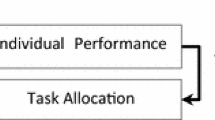Abstract
This paper focuses on multi-robot teams working cooperatively in an underwater application. Multi-robot teams working cooperatively to perform multiple tasks simultaneously have the potential to be more robust to failure and efficient when compared to single robot solutions. One key to more effective interaction is the ability to identify the behavior of other agents. However, the underwater environment presents specific challenges to teammate behavior identification. Current decentralized collaboration approaches, such as auction-based methods, degrade in poor communication environments. Sensor information regarding teammates can be leveraged to perform behavior recognition and task-assignment in the absence of communication. This work illustrates the use of Conditional Random Fields (CRFs) to perform behavior recognition as an approach to task monitoring in the absence of robust communication in a challenging underwater environment. In order to demonstrate the feasibility of performing behavior recognition of an AUV in the underwater domain, we use trajectory based techniques for model generation and behavior discrimination in experiments using simulated trajectories and real sonar data. Results are presented with comparison of a CRF method to one using Hidden Markov Models.
Access this chapter
Tax calculation will be finalised at checkout
Purchases are for personal use only
Preview
Unable to display preview. Download preview PDF.
Similar content being viewed by others
References
Videoray (2011), http://www.videoray.com/
Arkin, R.C.: Behavior-Based Robotics, ch. 9. MIT Press, Cambridge (1998)
Baxter, R., Lane, D., Petillot, Y.: Behaviour recognition for spatially unconstrained unmanned vehicles. Proceedings of the IJCAI 9, 1–8 (2009)
Baxter, R.H., Lane, D.M., Petillot, Y.: Recognising agent behaviour during variable length activities. In: Proceedings of The 19th European Conference on Artificial Intelligence (2010)
Benjamin, M., Schmidt, H., Newman, P., Leonard, J.: Nested autonomy for unmanned marine vehicles with moos-ivp. Journal of Field Robotics 27(6), 834–875 (2010)
Cao, Y., Fukunaga, A., Kahng, A.: Cooperative mobile robotics: Antecedents and directions. Autonomous Robots 4(1), 7–27 (1997)
Dias, M., Stentz, A.: A free market architecture for distributed control of a multirobot system. In: 6th International Conference on Intelligent Autonomous Systems (IAS-6), pp. 115–122 (2000)
Dudek, G., Jenkin, M., Milios, E., Wilkes, D.: A taxonomy for multi-agent robotics. Autonomous Robots 3(4), 375–397 (1996)
Gerkey, B., Mataric, M.: Sold!: Auction methods for multirobot coordination. IEEE Transactions on Robotics and Automation 18(5), 758–768 (2002)
Lafferty, J., McCallum, A., Pereira, F.: Conditional random fields: Probabilistic models for segmenting and labeling sequence data (2001)
Novitzky, M.: Improvement of multi-auv cooperation through teammate verification. In: Workshops at the Twenty-Fifth AAAI Conference on Artificial Intelligence (2011)
Novitzky, M., Pippin, C., Balch, T., Collins, T., West, E.: Behavior recognition of an auv using a forward-looking sonar. In: Workshops at the Robotics: Science and Systems, Los Angeles, CA (2011)
Rabiner, L.: A tutorial on hidden Markov models and selected applications in speech recognition. Proceedings of the IEEE 77(2), 257–286 (1989)
Sariel, S., Balch, T., Erdogan, N.: Naval mine countermeasure missions. IEEE Robotics & Automation Magazine 15(1), 45–52 (2008)
Sotzing, C., Lane, D.: Improving the coordination efficiency of limited-communication multi-autonomus underwater vehicle operations using a multiagent architecture. Journal of Field Robotics 27(4), 412–429 (2010)
Vail, D., Veloso, M.: Feature selection for activity recognition in multi-robot domains. In: Proceedings of AAAI, vol. 2008 (2008)
Vail, D., Veloso, M., Lafferty, J.: Conditional random fields for activity recognition. In: Proceedings of the 6th International Joint Conference on Autonomous Agents and Multiagent Systems, pp. 1–8. ACM (2007)
West, M., Novitzky, M., Varnell, J., Melim, A., Sequin, E., Toler, T., Collins, T., Bogle, J.: Design and development of the yellowfin uuv for homogenous collaborative missions (2010)
Author information
Authors and Affiliations
Corresponding author
Editor information
Editors and Affiliations
Rights and permissions
Copyright information
© 2014 Springer-Verlag Berlin Heidelberg
About this paper
Cite this paper
Novitzky, M., Pippin, C., Collins, T.R., Balch, T.R., West, M.E. (2014). Conditional Random Fields for Behavior Recognition of Autonomous Underwater Vehicles. In: Ani Hsieh, M., Chirikjian, G. (eds) Distributed Autonomous Robotic Systems. Springer Tracts in Advanced Robotics, vol 104. Springer, Berlin, Heidelberg. https://doi.org/10.1007/978-3-642-55146-8_29
Download citation
DOI: https://doi.org/10.1007/978-3-642-55146-8_29
Publisher Name: Springer, Berlin, Heidelberg
Print ISBN: 978-3-642-55145-1
Online ISBN: 978-3-642-55146-8
eBook Packages: EngineeringEngineering (R0)




